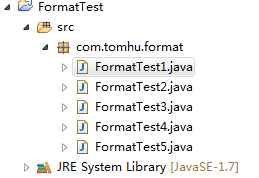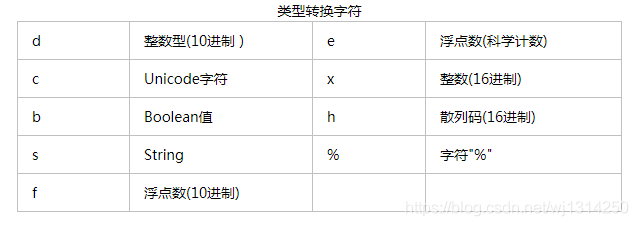在JavaSe5中,推出了C语言中printf()风格的格式化输出。这不仅使得控制输出的代码更加简单,同时也给与Java开发者对于输出格式与排列更大的控制能力。今天,我们开始学习Java中的格式化输出。
System.out.format()
由于内容比较简单,我们通过实例来加以说明。项目结构如下:

Java Se5引入的format方法可用于PrintStream或PrintWriter对象,其中也包括System.out对象。
package com.tomhu.format;
public class FormatTest1 {
public static void main(String[] args) {
int x = 5;
double y = 3.141592;
// 一般方式
System.out.println("x = " + x + ", y = " + y);
// printf()方式
System.out.printf("x = %d, y = %fn", x, y);
// format()方式
System.out.format("x = %d, y = %fn", x, y);
}
}
输出的结果如下:
x = 5, y = 3.141592
x = 5, y = 3.141592
x = 5, y = 3.141592
可以看到,format与printf是等价的,它们只需要一个简单的格式化字符串,加上一串参数即可,每个参数对应一个格式修饰符。
public PrintStream printf(String format, Object ... args) {
return format(format, args);
}
在format的具体代码中,其实就是调用Formatter的format方法:formatter.format(Locale.getDefault(), format, args);
public PrintStream format(String format, Object ... args) {
try {
synchronized (this) {
ensureOpen();
if ((formatter == null)
|| (formatter.locale() != Locale.getDefault()))
formatter = new Formatter((Appendable) this);
formatter.format(Locale.getDefault(), format, args);
}//加入Java开发交流君样:756584822一起吹水聊天
} catch (InterruptedIOException x) {
Thread.currentThread().interrupt();
} catch (IOException x) {
trouble = true;
}
return this;
}
Formatter类
在Java中,所有新的格式化功能都由Formatter类处理,上述的printf与format也是。可以将Formatter看作是一个翻译器,它将你的格式化字符串与数据翻译成需要的结果。当你创建一个Formatter对象的时候 ,需要向其构造器传递一些信息,告诉它最终的结果将向哪里输出
package com.tomhu.format;
import java.util.Formatter;
public class FormatTest2 {
public static void main(String[] args) {
String name = "huhx";
int age = 22;
Formatter formatter = new Formatter(System.out);
formatter.format("My name is %s, and my age is %d ", name, age);
formatter.close();
}//加入Java开发交流君样:756584822一起吹水聊天
}
它的输出结果如下:
My name is huhx, and my age is 22
格式化说明符
在插入数据时,如果想要控制空格与对齐,就需要精细复杂的格式修饰符,以下是其抽象的语法:
%[argument_index$][flags][width][.precision]conversion
The optional argument_index is a decimal integer indicating the position of the argument in the argument list. The first argument is referenced by "1$", the second by "2$", etc.
The optional flags is a set of characters that modify the output format. The set of valid flags depends on the conversion.
The optional width is a non-negative decimal integer indicating the minimum number of characters to be written to the output.
The optional precision is a non-negative decimal integer usually used to restrict the number of characters. The specific behavior depends on the conversion.
The required conversion is a character indicating how the argument should be formatted. The set of valid conversions for a given argument depends on the argument's data type.
最常见的应用是控制一个域的最小尺寸,这可以通过指定width来实现。Formatter对象通过在必要时添加空格,来确保一个域至少达到某个长度。在默认的情况下,数据是右对齐的,通过”-“标志可以改变对齐的方向。
与width相对的是precision(精确度),它用来指明最大尺寸。width可以应用各种类型的数据转换,并且其行为方式都一样。precision则不一样,不是所有类型的数据都能使用precision,而且,应用于不同的类型的数据转换时,precision的意义也不同。
precision应用于String时,它表示打印String时输出字符的最大数量
precision应用于浮点数时,它表示小数点要显示出来的位数。默认是6位小数,如果小数位数过多则舍入,过少则在尾部补零。
由于整数没有小数部分,所以precision不能应用于整数。如果你对整数应用precision,则会触发异常
package com.tomhu.format;
import java.util.Formatter;
public class FormatTest3 {
static Formatter formatter = new Formatter(System.out);
public static void printTitle() {
formatter.format("%-15s %-5s %-10sn", "huhx", "linux", "liuli");
formatter.format("%-15s %-5s %-10sn", "zhangkun", "yanzi", "zhangcong");
formatter.format("%-15s %-5s %-10sn", "zhangkun", "yanzhou", "zhangcong");
}//加入Java开发交流君样:756584822一起吹水聊天
public static void print() {
formatter.format("%-15s %5d %10.2fn", "My name is huhx", 5, 4.2);
formatter.format("%-15.4s %5d %10.2fn", "My name is huhx", 5, 4.1);
}
//加入Java开发交流君样:756584822一起吹水聊天
public static void main(String[] args) {
printTitle();
System.out.println("----------------------------");
print();
formatter.close();
}
}
它的输出结果如下:
huhx linux liuli
zhangkun yanzi zhangcong
zhangkun yanzhou zhangcong
----------------------------
My name is huhx 5 4.20
My n 5 4.10
Formatter转换
下面的表格包含了最常用的类型转换:

String.format()是一个static方法,它接受与Formatter.format()方法一样的参数,但返回一个String对象。当你只需要用format方法一次的时候,String.format()还是很方便的。
package com.tomhu.format;
public class FormatTest4 {
public static void main(String[] args) {
int age = 22;
String name = "huhx";
//加入Java开发交流君样:756584822一起吹水聊天
String info = String.format("My name is %s and my age is %d", name, age);
System.out.println(info);
}//加入Java开发交流君样:756584822一起吹水聊天
}
它的输出结果如下:
My name is huhx and my age is 22
其实String.format方法的实质还是Formatter.format(),只不过是做了简单封装而已:
public static String format(String format, Object... args) {
return new Formatter().format(format, args).toString();
}
简单的十六进制转换工具
package com.tomhu.format;
public class FormatTest5 {
public static String format(byte[] data) {
StringBuilder builder = new StringBuilder();
int n = 0;//加入Java开发交流君样:756584822一起吹水聊天
for(byte b: data) {
if (n %16 == 0) {
builder.append(String.format("%05x: ", n));
}//加入Java开发交流君样:756584822一起吹水聊天
builder.append(String.format("%02x ", b));
n ++;
if (n % 16 == 0) {
builder.append("n");
}
}
builder.append("n");
return builder.toString();
}
public static void main(String[] args) {
String string = "my name is huhx, welcome to my blog";
System.out.println(format(string.getBytes()));
}
}
输出结果如下:
00000: 6d 79 20 6e 61 6d 65 20 69 73 20 68 75 68 78 2c
00010: 20 77 65 6c 63 6f 6d 65 20 74 6f 20 6d 79 20 62
00020: 6c 6f 67

最新2020整理收集的一些高频面试题(都整理成文档),有很多干货,包含mysql,netty,spring,线程,spring cloud、jvm、源码、算法等详细讲解,也有详细的学习规划图,面试题整理等,需要获取这些内容的朋友请加Q君样:756584822
{{o.name}}
{{m.name}}





















 2077
2077











 被折叠的 条评论
为什么被折叠?
被折叠的 条评论
为什么被折叠?








